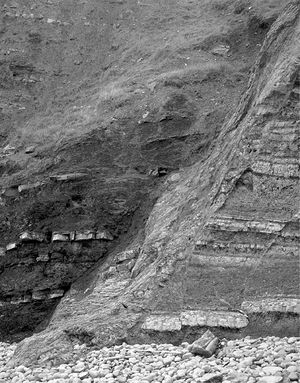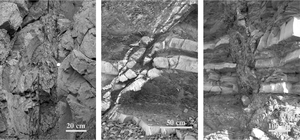Difference between revisions of "How fault zones affect seal"
Cwhitehurst (talk | contribs) |
Cwhitehurst (talk | contribs) m (added Category:Treatise Handbook 3 using HotCat) |
||
| (10 intermediate revisions by 3 users not shown) | |||
| Line 6: | Line 6: | ||
| part = Predicting the occurrence of oil and gas traps | | part = Predicting the occurrence of oil and gas traps | ||
| chapter = Evaluating top and fault seal | | chapter = Evaluating top and fault seal | ||
| − | | frompg = 10- | + | | frompg = 10-23 |
| − | | topg = 10- | + | | topg = 10-25 |
| author = Grant M. Skerlec | | author = Grant M. Skerlec | ||
| link = http://archives.datapages.com/data/specpubs/beaumont/ch10/ch10.htm | | link = http://archives.datapages.com/data/specpubs/beaumont/ch10/ch10.htm | ||
| Line 14: | Line 14: | ||
| isbn = 0-89181-602-X | | isbn = 0-89181-602-X | ||
}} | }} | ||
| − | Fault zones in siliciclastic sequences consist of various proportions of sand and shale. There is a relationship between seal behavior and the inferred sand-shale ratio of the fault zone. Sand-rich portions of the fault zone leak; shale-rich portions of the fault zone seal. Given the complex structure and composition of fault zones and the many factors that could affect a seal, it has been surprising to find such a simple relationship, basin after basin. | + | [[Fault]] zones in siliciclastic sequences consist of various proportions of [[sand]] and [[shale]]. There is a relationship between seal behavior and the inferred sand-shale ratio of the fault zone. Sand-rich portions of the fault zone leak; shale-rich portions of the fault zone seal. Given the complex structure and composition of fault zones and the many factors that could affect a seal, it has been surprising to find such a simple relationship, basin after basin. |
==Example: smear gouge== | ==Example: smear gouge== | ||
[[file:evaluating-top-and-fault-seal_fig10-20.jpg|300px|thumb|{{figure number|1}}Smear gouge along a normal fault found in a sequence of Permian-Carboniferous sand and shales near Lynemouth, U.K..]] | [[file:evaluating-top-and-fault-seal_fig10-20.jpg|300px|thumb|{{figure number|1}}Smear gouge along a normal fault found in a sequence of Permian-Carboniferous sand and shales near Lynemouth, U.K..]] | ||
| − | [[:file:evaluating-top-and-fault-seal_fig10-20.jpg|Figure 1]] is an example of smear gouge along a normal fault found in a sequence of Permian-Carboniferous sand and shales near Lynemouth, U.K. Ductile, light gray shales have been incorporated in the fault zone as a continuous layer sourced from a bed in the footwall (upper left). Similarly, a bed of coal (black) in the footwall and sandstone in the hanging wall have been incorporated as discontinuous fragments in the fault zone. The coal, however, is intensely fractured, reflecting brittle rather than ductile deformation. | + | [[:file:evaluating-top-and-fault-seal_fig10-20.jpg|Figure 1]] is an example of smear gouge along a [[normal fault]] found in a sequence of [[Permian]]-[[Carboniferous]] sand and shales near Lynemouth, U.K. Ductile, light gray shales have been incorporated in the fault zone as a continuous layer sourced from a bed in the [[footwall]] (upper left). Similarly, a bed of [[coal]] (black) in the [[footwall]] and sandstone in the [[hanging wall]] have been incorporated as discontinuous fragments in the fault zone. The coal, however, is intensely fractured, reflecting [[Brittleness|brittle]] rather than [[Ductility|ductile]] [[deformation]]. |
| − | Shale-rich gouge | + | Shale-rich [[gouge zone]]s can create impermeable barriers. The following, a normal fault in [[Jurassic]] and [[Triassic]] sediments near Lilstock, U.K., shows a gouge zone approximately [[length::5 m]] thick. The gouge consists predominantly of ductile shales and marls as well as small amounts of brittle limestones. Faults with similar shale-rich gouge in producing fields create seals. |
==Example: spectrum of gouge compositions== | ==Example: spectrum of gouge compositions== | ||
| − | [[file:evaluating-top-and-fault-seal_fig10-21.png|thumb|{{figure number|2}}Three fault zones exhibiting a spectrum of sand-shale ratios.]] | + | [[file:evaluating-top-and-fault-seal_fig10-21.png|thumb|300px|{{figure number|2}}Three fault zones exhibiting a spectrum of sand-shale ratios.]] |
Fault gouge can range from sand rich to shale rich. [[:file:evaluating-top-and-fault-seal_fig10-21.png|Figure 2]] shows three fault zones exhibiting a spectrum of sand-shale ratios. The table below describes the position of the three faults, their sequences and characteristics, and their location. | Fault gouge can range from sand rich to shale rich. [[:file:evaluating-top-and-fault-seal_fig10-21.png|Figure 2]] shows three fault zones exhibiting a spectrum of sand-shale ratios. The table below describes the position of the three faults, their sequences and characteristics, and their location. | ||
| Line 37: | Line 37: | ||
| Sand–siltstone | | Sand–siltstone | ||
| Gouge with high sand–shale ratio | | Gouge with high sand–shale ratio | ||
| − | | Tertiary, Isle of Wight, U.K. | + | | [[Tertiary]], Isle of Wight, U.K. |
|- | |- | ||
| Center | | Center | ||
| Line 54: | Line 54: | ||
* [[Quantitative fault seal analysis]] | * [[Quantitative fault seal analysis]] | ||
* [[Limitations of quantitative fault seal analysis]] | * [[Limitations of quantitative fault seal analysis]] | ||
| − | * [[ | + | * [[Fault seal analysis example: Gulf Coast]] |
==External links== | ==External links== | ||
| Line 63: | Line 63: | ||
[[Category:Predicting the occurrence of oil and gas traps]] | [[Category:Predicting the occurrence of oil and gas traps]] | ||
[[Category:Evaluating top and fault seal]] | [[Category:Evaluating top and fault seal]] | ||
| + | [[Category:Treatise Handbook 3]] | ||
Latest revision as of 16:52, 29 March 2022
| Exploring for Oil and Gas Traps | |

| |
| Series | Treatise in Petroleum Geology |
|---|---|
| Part | Predicting the occurrence of oil and gas traps |
| Chapter | Evaluating top and fault seal |
| Author | Grant M. Skerlec |
| Link | Web page |
| Store | AAPG Store |
Fault zones in siliciclastic sequences consist of various proportions of sand and shale. There is a relationship between seal behavior and the inferred sand-shale ratio of the fault zone. Sand-rich portions of the fault zone leak; shale-rich portions of the fault zone seal. Given the complex structure and composition of fault zones and the many factors that could affect a seal, it has been surprising to find such a simple relationship, basin after basin.
Example: smear gouge
Figure 1 is an example of smear gouge along a normal fault found in a sequence of Permian-Carboniferous sand and shales near Lynemouth, U.K. Ductile, light gray shales have been incorporated in the fault zone as a continuous layer sourced from a bed in the footwall (upper left). Similarly, a bed of coal (black) in the footwall and sandstone in the hanging wall have been incorporated as discontinuous fragments in the fault zone. The coal, however, is intensely fractured, reflecting brittle rather than ductile deformation.
Shale-rich gouge zones can create impermeable barriers. The following, a normal fault in Jurassic and Triassic sediments near Lilstock, U.K., shows a gouge zone approximately length::5 m thick. The gouge consists predominantly of ductile shales and marls as well as small amounts of brittle limestones. Faults with similar shale-rich gouge in producing fields create seals.
Example: spectrum of gouge compositions
Fault gouge can range from sand rich to shale rich. Figure 2 shows three fault zones exhibiting a spectrum of sand-shale ratios. The table below describes the position of the three faults, their sequences and characteristics, and their location.
| Position | Sequence | Characteristics | Location |
|---|---|---|---|
| Left | Sand–siltstone | Gouge with high sand–shale ratio | Tertiary, Isle of Wight, U.K. |
| Center | Limestone–shale | Gouge with intermediate “sand”–shale ratio | Jurassic, Kilve, U.K. |
| Right | Limestone–shale | Gouge with low “sand”–shale ratio | Jurassic, Kilve, U.K. |
See also
- Quantitative fault seal analysis
- Quantitative fault seal analysis
- Limitations of quantitative fault seal analysis
- Fault seal analysis example: Gulf Coast

